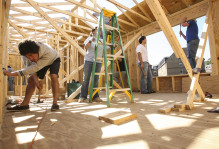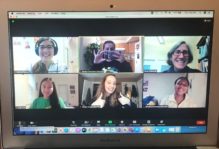It’s Not Linear; 2/28/14
In November 0f 2009, I wrote that SHC was becoming MANOS and that the timing seemed more than incidental. (And, it happened even before Chrissy Sherman joined the team.) It seemed clear to me then that the project was evolving from the “service learning” group of 2006 and was finding its way. The new name, Medical Aid Nicaragua: Outreach Scholarship, was in part a proclamation of vision: to learn, to research, to engage with, to be mindful of presumptions about what we’re doing and how it may be received by those with whom we intend to partner.
In a post dated March 11, 2010, I noted that we would begin this year to focus our community efforts in Chaguite. We estimated that there are about 40 houses in this community and by the end of the 2010 March trip, we were close to completing interviews in all of the homes. From the same trip, I described meeting with a local “brigidista.” His name is Ysidro and it’s clear that he works very hard to care for his family and still finds time to serve in a volunteer capacity that involves “looking after” the health and health care needs of the community.
And so it is 2014, and we keep coming back—now routinely three times each year, in some fashion: Small teams in January (like the one this year that facilitated community meetings with representatives of our newest partners from the Engineers Without Borders chapter at Cal Poly – Pomona); the full team each March; and a team of three to eight students in the summers. The work proceeds—slowly, deliberately, sometimes seemingly as much sideways as forward, but always as fully as possible in step with community partners. Chrissy Sherman ’14 has traveled to do research in the community eight times, as has Lester Chavez ’14. Other experienced team members have traveled from three to seven times each and, through that dedication, have developed understandings, appreciations, and real friendships within the community.
We now know the residents of the households in Chaguite, which number about 50. We have mapped the region, the households, the health problems and assets. We seem to be realizing the vision in our name—and we continue to worry about our presence, our role, our relationships, and our partnership. Through repeated interviews in all households in the community, we have come to know residents and we have learned about their health and healthcare concerns, needs, and priorities. We learned about the leaders and about interpersonal networks – those groups of people who communicate with one another and collaborate on occasion. In our earliest interviews, we were struck by the paucity of communications and collaboration even as residents were able to identify “leaders.” Residents told us that they did not work with leaders and that leaders did not work with them or understand their concerns and needs. Through Social Networks Analysis (SNA), we identified “organic” networks of communication, groups of residents who do talk together and we encouraged them to meet together and with us to help us to understand the health and healthcare priorities. They were modest in number, scope, and inclusiveness.
The social networks analysis (SNA) techniques enabled us to calculate measures of “network density” (the proportion of interpersonal connections reported as a proportion of the total possible connections for the respondents). It is an imperfect method and an imperfect indicator, but SNA measures of network density provide an empirical and quantitative way to gauge communications and collaboration within communities. In general, there is inadequate research to allow us to estimate what levels of density are “normal” or “typical,” but at a minimum, we can take measures at different points in time and compare these to observe change. Our first round of research provided a network density estimate of less than two percent – that is, of all the dyadic (two-person) relationships that might exist in the community, less than two percent were reported as existing.
We have been working with these organic groups (which we began calling “regional groups”) for several years now and through communications within and across these groups, have worked with residents to create and authorize a five-year plan to improve health and healthcare. Through these groups, we have partnered with the community to advance a project with Engineers Without Borders (EWB). We strongly suspect that our next round of SNA research will reveal significant changes in the level of estimated network density. We believe, further, that network density is crucial to the development of effective social infrastructure – the organizing of resources, activities, and tasks needed for communities to collaborate to build sustainable solutions to shared problems. We won’t know until we do a second round of systematic research, but it appears that levels of communication and collaboration have increased markedly over the last four years as we have encouraged engagement through the organic networks and participation through these in regular community meetings. (We’ll be sure to report our findings to Chrissy Sherman no matter where her FOMO efforts may take her next.)
This year, we undertook interviews in households that have not been represented regularly (or at all) in regional group meetings or community meetings. We are trying to understand how we might make engagement in community-level efforts to improve health more inviting, more accessible. We were accompanied by community members from the respective regional groups in our hope to engage residents more fully in our research efforts. The residents were more inclined to chastise those we visited than we preferred and we encouraged a point of view that emphasizes the value for all in increasing participation—particularly in the developing project to provide access to water for everyone in the community.
In a final note: Chrissy Sherman once drove for approximately 3 seconds in Nicaragua.




No comments.
Comments are currently closed. Comments are closed on all posts older than one year, and for those in our archive.